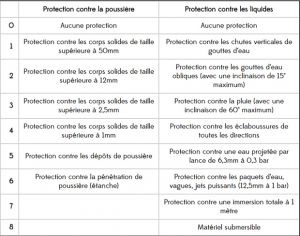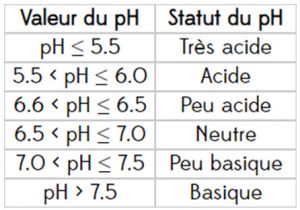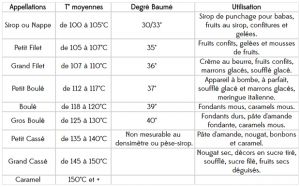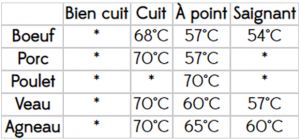What do you need help with ?
What do you need help with ?
General
What is temperature ?
Temperature is a physical quantity measured with a thermometer and studied in thermometry.
In everyday life, it is related to the sensations of cold and heat that arise from heat transfer between the human body and its environment.
Please note that there are likely to be measurement inaccuracies (measurement uncertainty) due to room temperature, for example.
How does a traditional glass expansion thermometer work ?
When the temperature rises, the liquid in the thermometer (mercury or other) heats up, expands and rises.
As the temperature drops, the liquid contracts and sinks as it cools.
Depending on the volume of liquid and the coefficient of expansion, a scale is associated with the measured temperature.
What is the difference between degrees Celsius and degrees Fahrenheit ?
These are different units of measurement for temperature.
Temperature can be measured in degrees Celsius (°C) or degrees Fahrenheit (°F).
The formula for changing from Fahrenheit to Celsius is complex:
°F = 9/5 × (°C + 40) ? 40 or °F = °C × 1.8 + 32
Example: If you are in a country where the temperature is displayed in Fahrenheit, subtract 32 from the displayed temperature and divide the result by 1.8.
Note : water freezes at 0°C and 32°F.
If it is 0°F outside, it means that the temperature is -17.8°C.
The human body is at 37°C and 98.6°F.
Water boils at 100°C and 212°F.
What is mercury ?
Mercury is a heavy and toxic metallic element, which is in liquid form at room temperature. It is used in thermometers, barometers, steam lamps and batteries.
It is also used in some pharmaceutical products. Mercury thermometers therefore contain a grey liquid unlike other thermometers.
The consumption of mercury in industry has decreased dramatically due to its toxicity.
Why was mercury used in thermometers ?
Mercury has very specific properties, including the ability to expand uniformly with temperature changes.
Hence the definition: any change in temperature is proportional to the change in length of the mercury column.
In contrast to the alcohols that were previously used, mercury has a large and constant expansion length, which makes it possible to measure the temperature quite accurately.
Attention : Mercury thermometers have been banned for sale in medical devices since 1st March 1999, for the general public since 2009 and for professionals with some exceptions since 2015. Mercury is dangerous to health, especially when the thermometer breaks. Mercury is toxic and causes an inflammatory reaction when in contact with liquid or vapours. In addition, the introduction of equally effective electronic thermometers has replaced them.
This ban also reduces sources of mercury, an environmental pollutant.
My mercury thermometer broke, what can I do ?
Above all, the affected area must be cleaned thoroughly and quickly.
Mercury evaporates at room temperature. The vapours mix with the air in the room and the inhaled mercury is quickly absorbed by the respiratory tract. It must therefore be picked up quickly before it evaporates.
– Do not use a vacuum cleaner The heat produced by the appliance promotes the formation of mercury vapours.
– Collect the metal balls with a sheet of paper and gather them on another sheet.
– For very small ones, you can use sticky paper.
– Ventilate the room to remove any fumes that may have formed.
– Put the thermometer debris and mercury in 2 plastic bags, seal them with tape and dispose of them with the small chemical waste at your local waste disposal centre.
Be careful not to throw the mercury down your sink as it will remain in the drain.
Special circumstances:
To remove mercury that has crept between floorboards, parquet floorboards or on a carpet :
– Collect as many of the metal balls as possible with one sheet of paper and then gather them on another sheet. For very small ones you can use sticky paper.
– Ventilate the room where the accident occurred. In this way, any mercury vapours that may have formed are eliminated. Do not use a vacuum cleaner in the room where the incident took place for 15 days.
What is the blue or red liquid inside a thermometer made of ?
These liquids are derived from petroleum (or distilled petroleum). These are mixtures of organic compounds (hydrocarbons) to which a dye is added (usually blue or red). These liquids are mildly irritating. At room temperature, the risk is not very great but in hot weather, the vapours must be removed by ventilating the room.
If you get liquid in your eyes: rinse your eyes and if the discomfort persists, consult your doctor.
What is thermometer calibration ?
Calibration is an essential operation for measuring or data retrieval equipment.
Two devices do not react in exactly the same way even if they belong to the same range.
Therefore, a procedure is needed to obtain the same result from the same initial situation.
To ensure the accuracy of your electronic device, it is recommended that youcalibrate it at 12-monthly intervals depending on the degree of use.
A glass thermometer is much more stable over time and a simple check every 5 years is sufficient.
What is the difference between calibration and certification ?
Calibration means “to measure”. The measuring instrument under test is calibrated against a known source. A certificate shows the results obtained during calibration and certifies the accuracy of the instrument.
How can you check the correct operation of your measuring instrument by measuring the 0°C point ?
Prepare a container with 0.5 litres of crushed ice. Add demineralised water to just below the surface of the ice. Allow the bath to stand for 10 minutes to equilibrate and then place the thermometer you wish to check in the middle of the bath. The temperature display should show 0°C but may vary by 1°C.
The instrument can be checked for proper operation using a calibrated laboratory thermometer and a water or oil bath, but also by steam.
What is an infrared thermometer or pyrometer ?
An infrared thermometer is an instrument that measures the surface temperature of an object from a distance.
These thermometers use infrared radiation, which is invisible. This is because its frequency is below the red in the visible spectrum of light.
What is waterproofing ?
Physical waterproofing prohibits the passage of a solid, fluid or gas. There is a table of IP ratings used to classify instruments according to their level of protection.
What is the difference between a hygrometer and a hydrometer ?
The hygrometer is an instrument for measuring the relative humidity of the air (hygrometry) using an external sensor, whereas the hydrometer is a device for measuring the static pressure of water.
The hydrometer uses Archimedes’ principle.
One is used to measure humidity and the other to measure water pressure. They should therefore not be confused.
Archimedes' principle or "push"
Any body immersed in a fluid at rest, entirely wetted by it or passing through its free surface, is subject to a vertical force, directed from bottom to top and opposed to the weight of the volume of displaced fluid; this force is called Archimedes’ thrust.
What is a temperature range ?
This is the minimum and maximummeasurement that a measuring device can take.
What is the purpose of an anemometer ?
This device measures wind speed and pressure.
What is a light meter ?
It is a device used to measure the illuminance on a surface.
What is a refractometer used for ?
An instrument that measures refractive indices. These indices are used to describe the behaviour of light in a medium other than a vacuum.
There are pocket refractometers for determining the concentration of sugar in fruit juices or acids in battery fluid.
A pocket refractometer is calibrated to read 0 when testing distilled water.
The refractometer is simple to use: the juice is placed on the “prism”, the lid is closed and the prism is exposed to the light for a direct reading.
What is a sound level meter ?
A device used to measure sound pressure or intensity level in the range of audible frequencies.
Why measure the pH ?
The pH gives an indication of the biological and chemical quality of a solution. This solution can be acidic or basic. The pH value 7 was chosen as a reference value for a neutral medium. The pH ranges from 0 (acidic) to 10 (basic/alkaline).
It is used in many business sectors: food processing, swimming pools, agriculture, gardening, etc
What is glassblowing ?
Glassblowing is a technique that allows glass to be made into larger or smaller hollow shapes. Today it is a sought-after skill that is less and less practised.
What is a 'custom' thermometer ?
STIL offers to make “custom” thermometers.
We offer to develop, adapt or create the measuring instrument which will meet your expectations, especially for you in France and also in Asia.
FOOD AND FOOD PRESERVATION
What does the legislation say about storage temperatures ?
There are two decrees concerning the storage temperature of food:
- the Decree of 21 December 2009 and Regulation 853/2004 which concerns foodstuffs of animal origin or foodstuffs containing them, storage, transport and sale temperatures.
- The Decree of 8 October 2013 for other foodstuffs.
What is the cold chain and what are its challenges ?
The cold chain is defined as all the operations that enable a low temperature to be maintained at all times (positive or negative depending on the product) to ensure the quality of the food during storage, transport, distribution and home storage…
the cold chain deals with all aspects relating to the product, from its production to its final consumption. This process ensures the quality of the products and, above all, prevents microbial growth in the products. Indeed, cold is very effective in limiting or stopping the proliferation of micro-organisms that can be dangerous to health (poisoning, etc.). Some bacteria thrive at low temperatures, so the cold chain must be constantly maintained.
Please note that the cold chain also includes food stored in the refrigerator, so care must be taken with the management of your appliances and the use-by dates.
What are the major risks of a break in the cold chain ?
There is no break in the cold chain if the temperature indicated on the product is not exceeded. Defrosting leads to the growth of germs and bacteria, which is why you should never refreeze a product.
The risks of a break in the refrigeration chain are as follows :
- appearance of germs (staphylococcus, salmonella, listeria, etc.)
- risk of listeriosis, a serious but rare disease that affects particularly weakened people such as children, pregnant women, elderly people..
- reduction in the shelf life of a product due to accelerated microbial growth.
- gastric problems related to stomach digestion or even food poisoning.
How to avoid or limit the risks of a break in the cold chain ?
- Never refreeze a product after thawing.
- Leave the food in a cool place.
- Wait until the last second to take out frozen (ice cream, etc.) or fresh products before moving them to the table.
- Eggs should be stored in the refrigerator.
- Pack leftovers properly and do not keep them in the refrigerator for more than 24 hours.
- Separate raw and cooked foods.
- Do not exceed the use-by dates labelled on the products.
- Clean your refrigerator regularly.
- Wash hands before and after handling food.DGCCRF (Directorate-General for Competition Policy, Consumer Affairs and Fraud Control) website on food preservation temperatures
What is the ideal temperature for a freezer ?
The freezer is used to store foodstuffs, so it is important to maintain the right temperature to avoid deterioration of the foodstuffs and to limit the energy consumption of the appliance.
The ideal storage temperature is between -16 and -18°C. Be careful not to set the temperature too low, as this will consume too much electricity (one degree too much consumes about 5% more electricity). The freezer should operate consistently without temperature variation.
It is important to know that there are different classes of appliances that allow a more or less important negative temperature for a more or less long conservation of foodstuffs (up to one year of conservation for a temperature of -24°C).
What is the ideal temperature for a refrigerator ?
The temperature of the refrigerator should be between 0°C and 5°C. This may vary slightly depending on the model of your appliance.
For good temperature maintenance, keep your fridge free of clutter and clean it once a month, and for a decent electricity bill, don’t set the temperature too low.
What is the ideal temperature for a wine cellar ?
To store wine, the temperature must be between 8°C and 15°C and must be constant because temperature variations and light are harmful to the wine. The humidity in the cellar should be at least 60%.
What is frying ?
When frying, the food is immersed in boiling fat or oil which serves as a medium for heat transfer. Frying is similar to a dehydration process at high temperature (160 to 190°C). It should be noted that oil is entirely composed of lipids and is therefore made up of 100% fatty acids.
What is the purpose of frying ?
The purpose of frying is to form a crust and change the colour, flavour and texture of the food. Potatoes are the most commonly fried food: Chips contain 8-15% fat and crisps up to 35%.
What is a good temperature to fry food well ?
The ideal temperature is 170°C (between 160°C and 180°C) above 190°C the oil degrades very quickly (overheating).
What are the current regulations concerning frying oil ?
According to Decree No. 2008-184 of 26 February 2008 on the application of the French Consumer Code with regard to edible fats and oils: […] art 8: “Fats and oils must not contain more than 25% polar compounds or 14% polymers of triglycerides. Oils not complying with the provisions of this paragraph shall be deemed unfit for human consumption” if this level is exceeded: a fine of €4,500 and/or imprisonment of three months or more are possible. Above 50% polar compounds, this penalty increases to €37,500 and two years’ imprisonment.
Why should I change my frying oil regularly ?
The frying oil is heated to a high temperature and repeatedly. Reactions with the oxygen in the air and the moisture in the food then take place and change the lipids that make up the oil. Hydrolysis, oxidation and polymerisation reactions of triglycerides then take place. These compounds will be found in varying proportions in foods.
The formation of these polar compounds occurs as the oils heat up. Beware, these compounds are dangerous to health. It must comply with the definitions and characteristics defined in Decree 2008-184: the rate of polar compound must not exceed 25%.
It is therefore important to check your frying oils regularly.
What temperature is needed to make caramel ?
What temperature should meat be cooked at ?
TEMPERATURE AND HOUSING
How can I heat my room without using too much electricity ?
It is possible to heat a room with wood, or oil-fired auxiliary heaters but also by having excellent insulation that limits heat loss. Ventilating the warm air to diffuse the heat, closing doors and windows are all aids to heat conservation.
When the house is unoccupied, do not hesitate to reduce the heating (17°C for a day, down to 14°C for a few days and around 10/12°C for more than a week). This reduces your electricity bill, while keeping heating to a minimum: one degree more is equivalent to a 7% increase in heating consumption.
What is "thermal comfort" ?
STIL, traditional know-how of measuring instruments
STIL has mastered the glassblowing technique ?
The ideal temperature for a bedroom is between 16°C and 20°C. For a baby’s room, the ideal temperature is between 18°C and 21°C.
TEMPERATURE AND OUTSIDE
What is the difference between the perceived temperature and the actual temperature ?
The perceived temperature is the temperature that the human body feels in everyday conditions, outside and not protected from the wind , unlike the real temperature (the more wind there is, the more this perceived temperature will decrease). The perceived temperature was introduced by Météo France (French national meteorological service) in 2008. This is an index.
The difference between the two temperatures is explained by the evaporation of water from the surface of the skin by the wind, which consumes energy. Humidity can also play a role in the perceived temperature.
What is the ideal water temperature for swimming ?
The temperature of the water depends on how it is to be used. For prolonged swimming, the ideal temperature is between 27°C and 29°C, because above 30°C it is considered that swimming no longer cools the body.
For competitive swimming, water at 26°C or 27°C should be prioritised to limit overheating during exercise and to encourage breathing and an increase in heart rate.
HEALTHCARE
How can the temperature of the human body be measured without body contact ?
The forehead thermometer is useful for quick and easy non-contact body temperature measurement. Here are some tips for using your thermometer effectively :
- Use it indoors and in a room where the room temperature is between 10 and 40°C maximum ;
- The thermometer must have been in the room where you are taking the measurement for 20 minutes and the person whose temperature is being measured for 10 minutes ;
- Your forehead should not be touched and should be completely clear: there should be no hair or head coverings touching the forehead that could interfere with the temperature reading ;
- Space each temperature reading a few seconds apart ;
- Always read the temperature with the same controller.
How do these thermometers work ?
- To switch it on, press the start button ;
- To read the temperature, press start or the trigger ;
- Point the thermometer at the forehead of the person to be monitored for 3 seconds at a distance of at least 1cm and no more than 3cm.
If you have any doubts, feel free to wipe your forehead, take 3 temperature readings (always a few seconds apart) and then take the average of the 3 readings.
Our thermometers are effective for the general public as well as for medical and childcare professionals.
Our 6040 and 6046 fever thermometers are certified to ISO13485/CE0197 standards.









